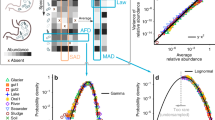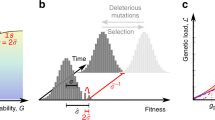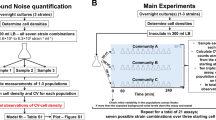Abstract
The evolutionary biologist “studies the steps by which the miraculous adaptations so characteristic of every aspect of the organic world have evolved”1. But the general nature of such adaptive steps is still unclear. Evolution is often thought to be random and dependent on unpredictable events2. In this light, one might expect the steps taken by adaptation to be completely random, both biologically and temporally. Here I present a mathematical derivation to show that, on the contrary, adaptive steps can have fairly strong rhythm. I find that the strength of the adaptive rhythm, that is its relative temporal regularity, is equal to a constant that is the same for all microbial populations. As a consequence, numbers of accumulated adaptations are predicted to have a universal variance/mean ratio. The theory derived here is potentially applicable to the study of molecular evolution.
This is a preview of subscription content, access via your institution
Access options
Subscribe to this journal
Receive 51 print issues and online access
$199.00 per year
only $3.90 per issue
Buy this article
- Purchase on Springer Link
- Instant access to full article PDF
Prices may be subject to local taxes which are calculated during checkout


Similar content being viewed by others
References
Mayr, E. Toward a New Philosophy of Biology 26 (Harvard Univ. Press, Cambridge, Massachusetts, 1988).
Gould, S. J. Wonderful Life: the Burgess Shale and the Nature of History (W. W. Norton, New York, 1989).
Hill, W. G. & Robertson, A. The effect of linkage on limits to artificial selection. Genet. Res. 8, 269–294 (1966).
Miralles, R., Gerrish, P. J., Moya, A. & Elena, S. F. Clonal interference and the evolution of RNA viruses. Science 285, 1745–1747 (1999).
Gerrish, P. J. & Lenski, R. E. The fate of competing beneficial mutations in an asexual population. Genetica 102–103, 127–144 (1998).
Fisher, R. A. The Genetical Theory of Natural Selection 102–104, 121–123 (Oxford Univ. Press, Oxford, 1930).
Muller, H. J. Some genetic aspects of sex. Am. Nat. 8, 118–138 (1932).
McVean, G. A. T. & Charlesworth, B. The effects of Hill-Robertson interference between weakly selected mutations on patterns of molecular evolution and variation. Genetics 155, 929–944 (2000).
Haigh, J. The accumulation of deleterious genes in a population—Muller's ratchet. Theor. Pop. Biol. 14, 251–267 (1978).
Robertson, A. in Mathematical Topics in Population Genetics (ed. Kojima, K.) 246–288 (Springer, Berlin, 1970).
Barton, N. H. The reduction in fixation probability caused by substitutions at linked loci. Genet. Res. 64, 199–208 (1994).
Morgan, T. H. Heredity and Sex (Columbia Univ. Press, New York, 1913).
Felsenstein, J. The evolutionary advantage of recombination. Genetics 78, 737–756 (1974).
Barton, N. H. Linkage and the limits to natural selection. Genetics 140, 821–841 (1995).
Otto, S. P. & Barton, N. H. The evolution of recombination: Removing the limits to natural selection. Genetics 147, 879–906 (1997).
de Visser, J. A. G. M., Zeyl, C. W., Gerrish, P. J., Blanchard, J. L. & Lenski, R. E. Diminishing returns from mutation supply rate in asexual populations. Science 283, 404–406 (1999).
Miralles, R., Moya, A. & Elena, S. F. Diminishing returns of population size in the rate of RNA virus adaptation. J. Virol. 74, 3566–3571 (2000).
Haldane, J. B. S. The mathematical theory of natural and artificial selection. Proc. Camb. Phil. Soc. 23, 838–844 (1927).
Hogg, R. V. & Craig, A. T. Introduction to Mathematical Statistics 59–67, 276 (Prentice Hall, Upper Saddle River, New Jersey, 1995).
Feller, W. An Introduction to Probability Theory and Its Applications Vol. 2, 346–359 (John Wiley & Sons, New York, 1968).
Gillespie, J. H. Population Genetics: A Concise Guide 77–82 (John Hopkins Univ. Press, Baltimore, 1998).
Ohta, T. & Kimura, M. On the constancy of the evolutionary rate of cistrons. J. Mol. Evol. 1, 18–25 (1971).
Wahl, L. M. & Krakauer, D. C. Models of experimental evolution: the role of genetic chance and selective necessity. Genetics 156, 1437–1448 (2000).
Orr, H. A. The rate of adaptation in asexuals. Genetics 155, 961–968 (2000).
Orr, H. A. The population genetics of adaptation: the distribution of factors fixed during adaptive evolution. Evolution 52, 935–949 (1998).
The WHO Network For HIV Isolation And Characterization. HIV type 1 variation in World Health Organization-sponsored vaccine evaluation sites: Genetic screening, sequence analysis, and preliminary biological characterization of selected viral strains. AIDS Res. Hum. Retroviruses 10, 1327–1343 (1994).
Thompson, J. D., Higgins, D. G. & Gibson, T. J. CLUSTAL W: Improving the sensitivity of progressive multiple sequence alignment through sequence weighting, position specific gap penalties and weight matrix choice. Nucleic Acids Res. 22, 4673–4680 (1994).
Felsenstein, J. PHYLIP—Phylogeny Inference Package (Version 3.2). Cladistics 5, 164–166 (1989).
Korber, B. T. SNAP: Synonymous-Nonsynonymous Analysis Program. Available at http://www.hiv.lanl.gov. (Theoretical Biology and Biophysics, Los Alamos National Laboratory, Los Alamos, New Mexico, 1998).
Acknowledgements
I thank C. Macken, T. Johnson, P. Sniegowski, A. Orr, D. Chencha, J. Gerrish, P. Baccam, R. Lenski and D. Krakauer for discussions. This work was supported in part by the Postdoctoral Fellowship program at Los Alamos National Laboratories and in part by the Laboratory Directed Research and Development program through financial support to C. Macken at Los Alamos National Laboratories.
Author information
Authors and Affiliations
Corresponding author
Rights and permissions
About this article
Cite this article
Gerrish, P. The rhythm of microbial adaptation. Nature 413, 299–302 (2001). https://doi.org/10.1038/35095046
Received:
Accepted:
Issue Date:
DOI: https://doi.org/10.1038/35095046
This article is cited by
-
Impacts of mutation effects and population size on mutation rate in asexual populations: a simulation study
BMC Evolutionary Biology (2010)
-
The Speed of Evolution in Large Asexual Populations
Journal of Statistical Physics (2010)
-
Molecular characterization of clonal interference during adaptive evolution in asexual populations of Saccharomyces cerevisiae
Nature Genetics (2008)
-
The genetic theory of adaptation: a brief history
Nature Reviews Genetics (2005)
-
Theories of adaptation: what they do and don?t say
Genetica (2005)
Comments
By submitting a comment you agree to abide by our Terms and Community Guidelines. If you find something abusive or that does not comply with our terms or guidelines please flag it as inappropriate.



